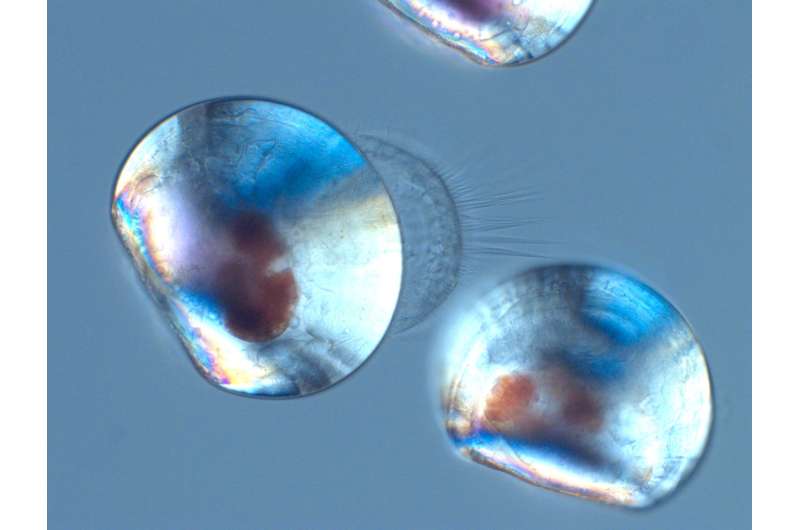Two-day-old mussels larvae viewed by a polarizing microscope. Credit: F. Melzner, GEOMAR.
Mussels are popular seafood in northern Germany. Mussels in their blue-black shells, are found in tidal regions of the coastal zones. Like many creatures in the oceans, which protect themselves with a calcareous shell from predators, mussels are endangered by the increasing acidification of seawater caused by the uptake of additional carbon dioxide from the atmosphere which is dissolved in seawater. Mussels are very sensitive to a decline in pH in early life stages. One important reason for this is the enormous calcification rate in the larval stage: between the first and second day of life they form a calcified shell, which corresponds to the weight of the rest of their body. This process is studied by scientists from Kiel and published in the international journal Nature Communications.
"For the first time, we used two different methods to understand the calcification of one to two-day-old shelled larvae to estimate their sensitivity to climate change", explains Kirti Ramesh, first author of the study and PhD student in the Ecophysiology group at GEOMAR and at the Integrated School on Ocean Sciences (ISOS) of the Cluster of Excellence "The Future Ocean". "With the help of fluorescent dyes and specialized microscopy techniques, we were able to track the deposition of calcium carbonate in living larvae and show that calcium carbonate is not formed intracellularly, as previously thought. It is more likely that calcium is acquired directly from the seawater and transported to the shell via specific transport proteins. Then, very close to the shell, the formation of calcium carbonate takes place", explains Kirti Ramesh.
In the second step, the team studied the abiotic conditions directly under the shell. With tiny glass microelectrodes, calcium, pH and carbonate were measured in larvae measuring only tenths of a millimetre. "For the first time, we have been able to show that the mussel larvae are able to increase the pH and the carbonate concentration below the shell, which then leads to higher rates of calcification ", explains Dr. Frank Melzner, Head of the Ecophysiology Working Group at GEOMAR. "However, with increasing acidification, the pH values below the shell also decrease, which leads to reduced calcification rates and, at very high CO2 concentrations, shell dissolution and increased mortality occurs", "Melzner continues. However, it is interesting, that the shells dissolve only at very low pH values. This suggests that organic constituents of the larval mussel shell contribute to dissolution resistance.
"With these results, we can establish a direct relationship between the calcification rate of mussels and the carbonate chemistry of seawater," explains Prof. Dr. Markus Bleich, Head of the Physiological Institute at Kiel University. According to Bleich, the reason for the high sensitivity of mussel larvae to acidification is the limited ion regulation capacity of the mussel larvae.
What's next? "We will use genetic and proteomic methods to investigate which proteins play a role in the transport of calcium and carbonate, and which organic substances in the shell increase their dissolution resistance. Findings from our laboratory show that some mussel populations, especially from the Baltic Sea, are more tolerant to ocean acidification. "We think that the key to increased resistance of mussel shells to dissolution lies in the variation of organic shell constituents", says Melzner. More tolerant populations could finally be the winners of climate change.
More information: Kirti Ramesh et al, Mussel larvae modify calcifying fluid carbonate chemistry to promote calcification, Nature Communications (2017). DOI: 10.1038/s41467-017-01806-8
Journal information: Nature Communications
Provided by Helmholtz Association of German Research Centres
























